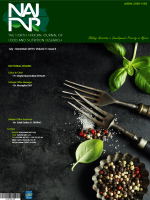Main Article Content
Viability of lactic acid bacteria in different components of ogi with anti diarrhoeagenic E. coli activities
Abstract
Background: Ogi constitutes a rich source of lactic acid bacteria (LAB) with associated health benefits to humans through antimicrobial activities. However, the high viability of LAB in Ogi and its supernatant (Omidun) is essential.
Aims: This study was carried out to assess the viability of LAB in various forms of modified and natural Ogi and the antimicrobial properties of Omidun against diarrhoeagenic E coli.
Methods and Material: The viability of LAB was assessed in fermented Ogi slurry and Omidun for one monthand also freeze-dried Ogi with and without added bacterial strains for two months. A further 10 days viability study of modified Omidun,refrigerated Omidun, and normal Ogi was performed. The antimicrobial effects of modified Omidun against five selected strains of diarrhoeagenic E. coli (DEC) were evaluated by the co-culture method.
Results: Both drying methods significantly affected carotenoids and phenolic compounds. The Ogi slurry had viable LAB only for 10 days after which, there was a succession of fungi and yeast. Omidun showed 2 log10cfu/mL reduction of LAB count each week and the freeze-dried Ogi showed progressive reduction in viability. Refrigerated Omidun has little viable LAB, while higher viability was seen in modified Omidun (≥2 log cfu/mL) than normal Omidun. Modified Omidun intervention led to 2-4 log reduction in diarrhoeagenic E. coli strains and total inactivation of shigella-toxin producing E. coliH66D strain in co-culture.
Conclusions: The consumption of Ogi should be within 10 days of milling using modified Omidun. There are practical potentials of consumption of Omidun in destroying E. coli strains implicated in diarrhea







